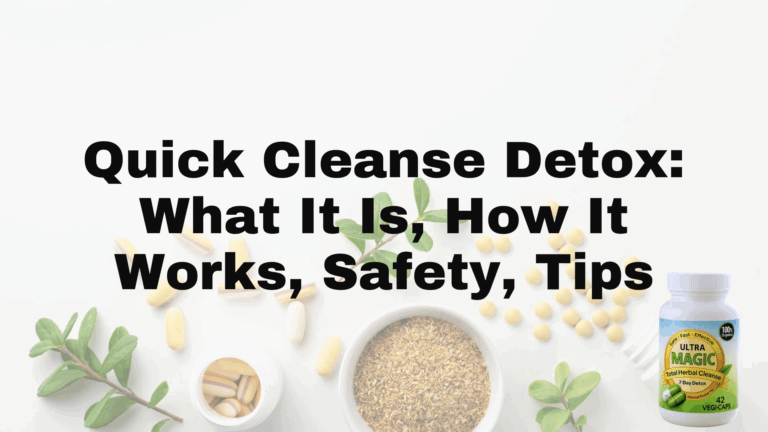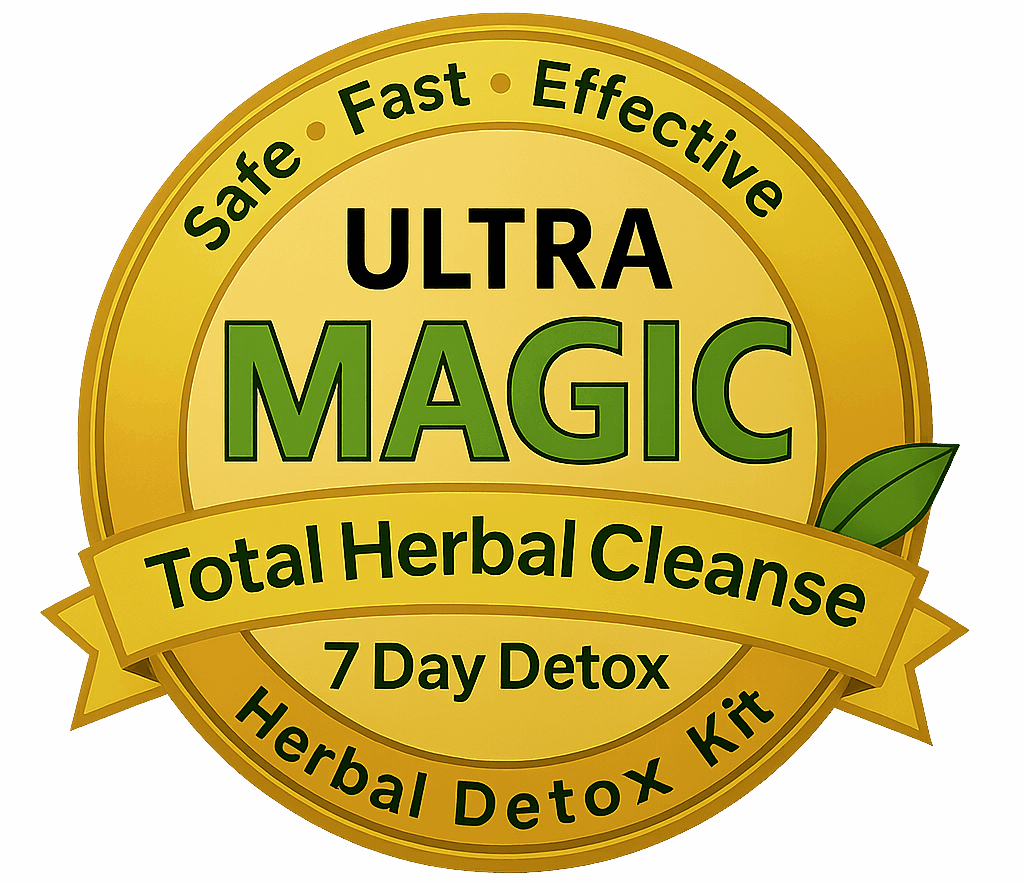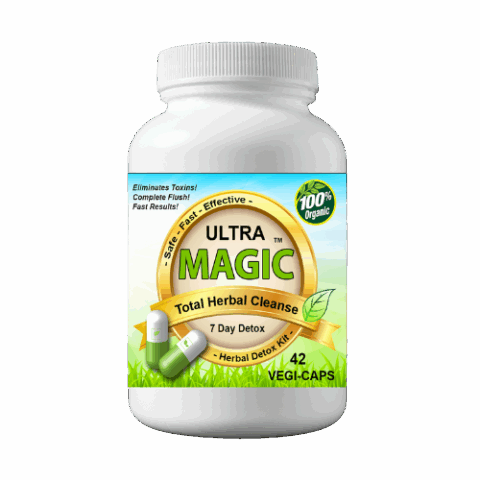
Quick Cleanse Detox: What It Is, How It Works, Safety, Tips
A quick cleanse detox is a short, structured reset—typically 24 hours to 7 days—focused on simple, whole foods, smart hydration, gentle movement, and sometimes herbal support. The aim is to step back from ultra-processed foods, alcohol, and excess sugar so your body’s own detox systems can do their job with fewer roadblocks. It’s not a magic eraser for toxins, guaranteed weight loss, or a workaround for drug tests; early shifts are often water and bloat, not body fat. Think of it as a brief, intentional pause that can help you feel lighter, reduce cravings, and reboot better habits.
In this guide, you’ll learn the difference between a cleanse, a detox, and a fast; how your liver, kidneys, gut, lungs, and skin naturally handle toxins; what science actually says about quick cleanses; and safe 24-hour, 3-day, and 7-day options with sample plans. We’ll outline what to eat and drink, common herbal ingredients, safety red flags, how to choose quality products, an herbal 7-day option, and important notes about drug-testing claims. Let’s start by clarifying the terms.
Cleanse vs detox vs fast: what’s the difference?
People often swap these terms, but there aren’t standardized scientific definitions. Generally, “cleanses” and “detoxes” involve consuming specific foods, juices, teas, or supplements marketed to “flush” toxins, while a “fast” is a complete or near-complete break from calories for a set period. Many quick programs blend elements of both.
- Cleanse/Detox: Structured intake (e.g., juices, herbs) that claims to support toxin removal. Your body already handles toxins via its own systems.
- Fast: Time-based calorie restriction (from hours to days). It may cause headaches, weakness, or dehydration if done improperly.
- Quick cleanse detox (here): A short reset (24 hours to 7 days) emphasizing whole foods, hydration, and gentle routines—without extreme starvation tactics.
How your body naturally detoxifies (liver, kidneys, gut, lungs, skin)
Before you try any quick cleanse detox, remember your body already runs a 24/7 cleanup crew. The real play is reducing incoming stressors (alcohol, ultra-processed foods, excess sugar) and supporting the organs that filter, process, and move waste out. When you do that, your system can do its job more efficiently—no extreme fixes required.
- Liver: Your chief filter. It transforms alcohol, drugs, and metabolic byproducts into forms that exit via bile or urine.
- Kidneys: Fine-tune fluids and electrolytes while filtering blood to remove urea, excess minerals, and water-soluble wastes in urine. Hydration helps.
- Gut: The lining blocks harmful compounds; fiber and regular bowel movements carry waste and spent bile out.
- Lungs: Exhale carbon dioxide and certain volatile compounds with every breath.
- Skin: Sweating removes small amounts of waste, but its primary role is protective; most detox work happens in the liver and kidneys.
Daily basics—drink water, sleep well, eat antioxidant- and fiber-rich foods, and stay active—bolster this built-in system.
Do quick cleanses work? What the science actually says
Short answer: not the way ads promise. Large health authorities note that your body already has a robust detox system, and research does not show that “detox diets” or drinks remove specific toxins or create lasting weight loss. The few studies that exist are small and low quality. Early scale drops during a quick cleanse detox usually reflect calorie cuts and shifts in water (often from eating fewer ultra-processed foods, sugar, and salt), not fat loss, and weight commonly returns once regular eating resumes.
Fasting protocols are being studied for potential benefits, but there are no firm conclusions for broad health outcomes, and side effects like headaches, weakness, and dehydration are possible. The most evidence-backed approach is supporting your built-in detox with daily habits: adequate sleep, hydration, antioxidant- and fiber-rich whole foods, and regular activity. Used thoughtfully, a short reset can help you break routines and feel lighter—but it’s not a toxin flush, a medical treatment, or a shortcut for drug testing.
- What a quick cleanse can do: reduce bloat, curb cravings, refocus habits.
- What it can’t do: “pull” toxins from organs, melt fat fast, guarantee test outcomes.
Quick cleanse detox methods: 24-hour, 3-day, and 7-day options
A quick cleanse detox can be as simple as a one-day reset or as structured as a full week. Choose the shortest plan that fits your timeline and current habits, and keep it rooted in whole foods, hydration, sleep, and light movement. Remember, these resets support your body’s own detox systems; they’re not a replacement for medical care or a promise of lasting fat loss.
- 24-hour reset: Prioritize water, unsweetened tea/coffee, vegetables, lean protein, fruit, and fiber; cut alcohol, ultra-processed foods, and added sugar; go for an early bedtime.
- 3-day gentle cleanse: Build plates around vegetables, legumes, whole grains, and quality protein; hydrate steadily; walk daily; avoid alcohol and highly processed snacks.
- 7-day structured plan: Set consistent meals, high-fiber plants, adequate protein, steady hydration, and sleep; consider vetted herbal support only if appropriate and safe with your meds.
What to expect during a short cleanse (benefits, limits, timelines)
Go in with realistic goals. A quick cleanse detox may reduce bloat, reset cravings, improve regularity, and nudge better sleep—mostly from eating fewer ultra-processed foods and salt, drinking more water, and getting consistent meals. Early scale drops usually reflect water shifts, not fat loss. Mild headaches, fatigue, or lightheadedness can occur—especially if you cut caffeine or sugar—so prioritize hydration, electrolytes from whole foods, and gentle movement.
- 0–24 hours: Less puffiness and salt bloat; possible headache or energy dip; earlier bedtime helps.
- 48–72 hours: Cravings ease; steadier energy if protein and fiber are adequate; bowel regularity often improves.
- Days 4–7: You may feel lighter and more “in routine.” Any weight change remains mostly fluid/glycogen.
- Limits: Cleanses don’t “pull” toxins or melt fat; results fade if habits revert; not a drug-test solution or medical treatment.
Detox drinks and hydration: what to drink and what to skip
When it comes to a quick cleanse detox, your best “detox drink” is water. Hydration helps your liver and kidneys move waste products out through urine; you don’t need extreme flushes or pricey concoctions. Large health authorities note that “detox drinks” aren’t proven to pull toxins, and some products (especially laxative or diuretic teas) can cause diarrhea, dehydration, or electrolyte problems. Also be cautious with unpasteurized juices and high-oxalate blends (like beet or spinach-heavy) if you’re prone to kidney stones, and skip alcohol.
- Drink more of: plain water; mineral or sparkling water; unsweetened herbal/green/black tea; black coffee if you already use caffeine; light broths; water with lemon or diluted 100% fruit juice.
- Skip or limit: alcohol; sugary sodas and energy drinks; “detox teas” with laxatives/diuretics; unpasteurized juices; juice-only days or “gallon challenges” that can trigger electrolyte imbalances—especially if you’re not eating.
Foods to focus on and foods to limit during a cleanse
During a quick cleanse detox, build simple plates that keep you satisfied while supporting your body’s natural detox pathways. Prioritize fiber for regularity, antioxidants to counter oxidative stress, adequate protein for steady energy, and healthy fats to absorb nutrients. A practical rule: fill at least two-thirds of your plate with plants, with the remaining third as quality protein.
- Pile on plants: Colorful vegetables and fruits (leafy greens, crucifers, berries, citrus) for antioxidants and fiber.
- Choose high‑fiber carbs: Oats, quinoa, brown rice, sweet potatoes, beans, lentils to support regularity.
- Include quality protein: Fish, eggs, poultry, tofu, or legumes to stabilize appetite and energy.
- Use healthy fats: Olive oil, avocado, nuts, and seeds to aid nutrient absorption and satisfaction.
- Flavor simply: Herbs, spices, lemon, and vinegar instead of heavy sauces.
- Skip ultra‑processed snacks: Chips, candies, packaged pastries, and fast food.
- Cut added sugars/refined carbs: Sodas, sweets, white bread, and sugary cereals.
- Limit processed/fried meats: Bacon, sausages, deli meats, and deep‑fried items.
- Watch the salt bombs: Heavy sauces, instant noodles, and salty takeout that drive bloat.
- Avoid alcohol: It burdens the liver and works against your reset.
Sample 24-hour reset plan
A 24-hour quick cleanse detox is a simple, satisfying day: steady water, balanced meals, light movement, and an early bedtime. Sip water regularly (tea or black coffee if you already use caffeine) and skip alcohol, ultra-processed foods, added sugar, and salty takeout.
- Morning: 16 oz water; tea/coffee; protein + fiber breakfast.
- Midday: Big salad + protein + whole grain; fruit if needed.
- Evening: Veggie bowl + legumes/tofu; 20–30 min walk; early sleep.
Sample 3-day gentle cleanse plan
This 3-day gentle cleanse keeps you nourished—three balanced meals, optional snacks, and steady water—built around plants, fiber-rich carbs, quality protein, and healthy fats. No juice-only days or laxative teas. Skip alcohol and ultra-processed foods, go light on salt, sleep 7–8 hours, and take an easy 20–30 minute walk daily. This quick cleanse detox supports your natural systems without energy crashes.
- Day 1: Hydrate; oats + berries; salad with protein + quinoa; fruit snack; roasted veggies + salmon or beans; walk, early sleep.
- Day 2: Hydrate; veggie scramble or tofu + avocado; lentil soup + greens; carrots + hummus; veggie stir-fry + tofu or shrimp; herbal tea.
- Day 3: Hydrate; chia pudding + fruit; grain bowl (farro) + beans + greens; apple + nut butter; baked chicken or tempeh + broccoli + sweet potato.
Sample 7-day structured plan
Seven days gives you enough runway to turn a quick cleanse detox into sustainable routines—without crash dieting. Keep meals simple and repeatable, hydrate steadily, move daily, sleep 7–8 hours, and avoid alcohol, ultra-processed foods, and added sugars. Use whole foods first; skip laxative/diuretic “detox” teas, and consider any herbal support only if appropriate for you.
- Daily framework: Water and unsweetened tea/coffee; three balanced meals built around vegetables, fiber-rich carbs, quality protein, and healthy fats; 20–30 minutes of easy movement; lights-out on time.
- Days 1–2 (reset): Cut alcohol and junk; big salads, soups, grain bowls; light broth or herbal tea at night.
- Days 3–4 (fiber focus): Add beans/lentils; rotate cruciferous veggies; include berries/citrus.
- Days 5–6 (protein rhythm): Keep protein at each meal; roast a sheet pan of veggies; stick with whole grains.
- Day 7 (consolidate): Review wins, plan next week’s grocery list, and keep the same plate pattern.
If you have medical conditions or take medications, check with your clinician before starting.
Safety first: who should skip a quick cleanse and who should talk to a doctor
A quick cleanse detox isn’t for everyone. National health authorities caution that “detox” programs often lack evidence and that extreme versions—juice-only days, laxative/diuretic teas, colon irrigation, or multi‑day fasts—can cause diarrhea, dehydration, electrolyte problems, or illness from unpasteurized juices. MD Anderson specifically advises cancer patients to avoid cleanses and fasts during treatment. If you have medical conditions or take medications, vet any plan with your clinician before you start.
- Skip a cleanse if: you’re undergoing cancer treatment or are immunocompromised; the plan pushes colon irrigation (especially with GI disease, prior colon surgery, severe hemorrhoids, kidney or heart disease); it relies on unpasteurized juices; or it requires drinking large volumes of water/herbal tea with little to no food for days.
- Talk to your doctor first if you have: diabetes; kidney disease or a history of kidney stones (high‑oxalate juices like beet/spinach can be risky); heart disease; significant GI disorders; or you’re on prescription medicines that could interact with “detox” products or restrictive diets.
Side effects to watch for and how to reduce risks
Even short, food-based quick cleanse detox plans can come with side effects. Headaches, fatigue, and lightheadedness are common—especially with fasting or abrupt caffeine/sugar cuts. Laxative or diuretic “detox” teas and colon cleanses can cause diarrhea, dehydration, and dangerous electrolyte shifts. Very large fluid intakes with little food carry similar risks. Unpasteurized juices can cause illness, and high‑oxalate blends (like spinach or beet heavy) may be an issue for people prone to kidney stones. Fasting may also trigger weakness or fainting.
- Keep it food-first: Eat regular, balanced meals with protein, fiber, and healthy fats.
- Hydrate, don’t overdo it: Sip steadily; aim for pale‑yellow urine rather than chugging.
- Skip risky aids: Avoid laxative/diuretic detox teas and colon irrigation.
- Play it safe with juices: Choose pasteurized; limit high‑oxalate mixes if stone‑prone.
- Taper caffeine: Reduce over 2–3 days to curb headaches.
- Know when to stop: If you have severe dizziness, rapid heartbeat, persistent vomiting/diarrhea, or signs of dehydration, end the cleanse and seek medical advice.
Common detox ingredients and herbs, explained
Many quick cleanse detox products include botanicals. It’s smart to keep expectations realistic: large health authorities note limited evidence that herb blends “flush toxins,” and some detox programs rely on laxatives or diuretics that can cause diarrhea, dehydration, or electrolyte problems. If you use herbs, keep it food-first, short-term, and check for medication interactions—especially if you have health conditions or are in treatment where diet and supplements can interfere with care.
- Burdock root: A traditional bitter root often used in tonics and teas.
- Dandelion root: Common in herbal teas used during short resets.
- Rhubarb root: Frequently included in classic cleanse-style formulas.
- Goldenseal: A longstanding North American herb found in many blends.
- Sheep sorrel: A leafy herb appearing in older herbal mixtures.
- Cat’s claw bark: A South American vine used in traditional preparations.
- Pau d’arco bark: A tree bark tea common in folk practices.
Choose gentle, whole‑food plans first; if adding herbs, use modest doses, avoid “extra strength” laxative/diuretic combos, and stop if you experience GI upset, dizziness, or rapid heartbeat.
How to choose a detox product safely (labels, testing, quality)
If you decide to use a product as part of a quick cleanse detox, treat it like you would a medication: safety first, claims second. Major health authorities note limited evidence for “detox” products and warn about hidden ingredients, laxative/diuretic formulas, and false promises. Favor food-first, short-term approaches and scrutinize labels, testing, and directions before you buy.
- Be claims‑savvy: Avoid products that promise disease treatment, “overnight flushes,” or guaranteed drug‑test outcomes.
- Demand label transparency: Full ingredient list with exact amounts; avoid vague “proprietary blends.”
- Check testing and manufacturing: Look for third‑party lab testing/COAs, lot numbers, GMP‑certified facilities, and clear company contact info.
- Screen for risky aids: Skip laxative/diuretic “detox teas,” colon cleanses, and unpasteurized juices; watch oxalate‑heavy blends if stone‑prone.
- Assess directions: Reasonable dosing and duration; no extreme fasting or “gallon” fluid pushes.
- Review warnings: Interactions, pregnancy, medical conditions, and when to stop; when in doubt, ask your clinician—especially with diabetes, kidney issues, heart disease, GI disorders, or during cancer treatment.
About Ultra Magic Detox: a 7-day herbal cleanse option
Ultra Magic Detox is a 7‑day herbal cleanse from Magic Detox built around a maximum‑strength blend of seven organic herbs—burdock root, dandelion root, rhubarb root, goldenseal, sheep sorrel, cat’s claw, and pau d’arco. It’s positioned as full‑body support in capsule form: natural, non‑GMO, and lab‑tested for purity and potency.
- Quality & manufacturing: Made in the USA (St. Augustine, FL) in a GMP‑certified, FDA‑registered facility.
- Convenience: Tasteless capsules; discreet, fast shipping.
- Assurance: 30‑day no‑questions‑asked refund policy.
- Important: Not a medical treatment or drug‑test guarantee; consult your clinician if you have conditions or take medications.
Preparing for your cleanse and easing back afterward
Pick a realistic start date and set gentle expectations. If you have medical conditions or take medications, confirm your plan is safe first. For a smooth quick cleanse detox, make small changes ahead of day one and plan an easy re‑entry so the benefits don’t vanish on day eight.
- 2–3 days out: cut alcohol/ultra‑processed, taper caffeine, hydrate.
- Stock basics: vegetables, beans/lentils, whole grains, protein, healthy fats.
- During: regular meals, steady water, skip laxative teas/unpasteurized juices.
- After 48–72 hours: reintroduce slowly; keep protein+fiber; limit salt/alcohol.
How to support your body’s detox system every day
The best “detox” is what you do consistently. Daily habits help your liver, kidneys, gut, lungs, and skin work smoothly long after any quick cleanse detox. Keep it simple: sleep enough, hydrate, eat mostly plants with adequate protein, move your body, and avoid the things that burden your system (alcohol, ultra‑processed foods, excess sugar and salt).
- Hydrate on schedule: Sip water to pale‑yellow urine; add unsweetened tea or black coffee if you already use caffeine.
- Prioritize sleep: Aim for 7+ hours nightly to support recovery and waste clearance.
- Build plant‑heavy meals: Vegetables, fruits, legumes, whole grains, plus quality protein and healthy fats.
- Limit alcohol and ultra‑processed foods: They add strain and crowd out nutrients.
- Stay active: Target 150–300 minutes/week moderate exercise (or 75–150 vigorous).
- Keep fiber daily: Beans, lentils, oats, berries, and greens for regularity and satiety.
Important notes about drug testing and detox claims
Straight talk: no cleanse, drink, herb, sauna, sweat session, or quick cleanse detox can guarantee a negative drug screen. Major health authorities report no compelling evidence that “detox diets” remove specific toxins from the body, and the FDA/FTC have taken action against companies making false or unsafe detox claims. Test results are driven by biology and timing—not marketing promises.
- No guarantees: “Pass-any-test” or “overnight flush” claims are red flags.
- Skip risky tactics: Extreme water chugging, laxative/diuretic teas, colon cleanses, or juice-only plans can cause dehydration, electrolyte problems, or illness—and are unlikely to change outcomes.
- Stay within the rules: Don’t use adulterants or unapproved devices; focus on safe, legal health practices.
- Use cleanses for habits, not hacks: A short reset can help you eat better, hydrate, and sleep—but it’s not a workaround for employment or legal testing.
- When in doubt: If testing is required, follow official instructions and speak with your healthcare provider for guidance on safe, lawful choices.
Frequently asked questions
Quick answers to the questions we hear most about short resets. Use them to keep your quick cleanse detox safe and realistic.
- Will it flush toxins fast? No. Evidence is lacking; early changes are mostly water, not fat.
- Is a 24-hour cleanse safe? For healthy adults, yes if food-first and hydrated.
- Detox teas/colon cleanses? Skip them; laxatives/diuretics and irrigation risk dehydration/electrolyte issues.
- Who should ask a doctor? Cancer treatment, diabetes, kidney/heart/GI disease, or immunocompromised.
- Pass a drug test? No legitimate guarantees; avoid “pass-any-test” claims.
Key takeaways
Quick cleanses are short, food‑first resets that support what your body already does. Set realistic expectations, lean on hydration, fiber, sleep, and movement, and avoid extreme tactics or miracle claims. Safety comes first.
- Your body detoxifies itself: liver, kidneys, gut, lungs, skin.
- Resets help habits, not “pull toxins” or melt fat.
- Hydration and whole foods beat laxative/diuretic teas or colon cleanses.
- Some people should avoid/ask a doctor, especially during treatment.
- No cleanse can guarantee a negative drug test.
Ready for a simple, 7‑day, herb‑forward option? Explore Ultra Magic Detox at Magic Detox.



